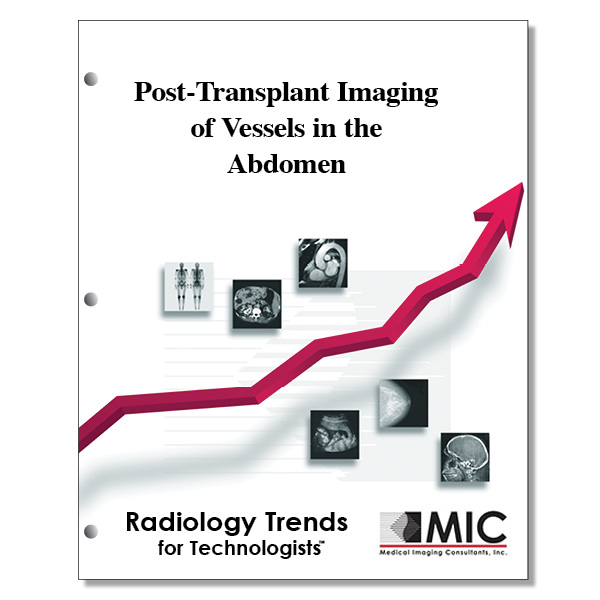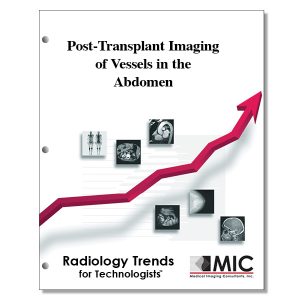

Post-Transplant Imaging of Vessels in the Abdomen
Vascular complications associated with abdominal transplantation are presented.
Course ID: Q00404 Category: Radiology Trends for Technologists Modalities: CT, MRI, Nuclear Medicine, Sonography, Vascular Interventional4.0 |
Satisfaction Guarantee |
$39.00
- Targeted CE
- Outline
- Objectives
Targeted CE per ARRT’s Discipline, Category, and Subcategory classification for enrollments starting after April 6, 2023:
[Note: Discipline-specific Targeted CE credits may be less than the total Category A credits approved for this course.]
Computed Tomography: 2.50
Procedures: 2.50
Abdomen and Pelvis: 2.50
Magnetic Resonance Imaging: 3.50
Patient Care: 1.00
Patient Interactions and Management: 1.00
Procedures: 2.50
Body: 2.50
Nuclear Medicine Technology: 3.00
Patient Care: 1.00
Patient Interactions and Management: 1.00
Procedures: 2.00
Gastrointestinal and Genitourinary Procedures: 2.00
Registered Radiologist Assistant: 4.00
Procedures: 4.00
Abdominal Section: 4.00
Sonography: 4.00
Patient Care: 1.00
Patient Interactions and Management: 1.00
Procedures: 3.00
Abdomen: 3.00
Vascular-Interventional Radiography: 3.00
Procedures: 3.00
Vascular Diagnostic Procedures: 2.50
Vascular Interventional Procedures: 0.50
Vascular Sonography: 4.00
Patient Care: 1.00
Patient Interactions and Management: 1.00
Procedures: 3.00
Abdominal/Pelvic Vasculature: 3.00
Outline
- Introduction
- Transplantation Procedures in the Abdomen
- Liver Transplantation
- Renal Transplantation
- Pancreas and Islet Transplantation
- Intestinal Transplantation
- Vascular and Related Complications after Transplantation
- Arterial Thrombosis
- Arterial Stenosis
- Venous Thrombosis and Stenosis
- Arteriovenous Fistulas
- Pseudoaneurysms
- Conclusion
Objectives
Upon completion of this course, students will:
- communicate the location of the liver
- understand the types of liver transplants
- explain the blood flow to and from the liver
- differentiate between types of liver transplants and survival rates
- articulate the type of anastomosis utilized in liver transplantation
- list the potential causes for end stage renal disease
- know the most common reason for kidney transplant
- discuss the donor types for kidney transplant
- verbalize patient wait times for living donor kidney transplants
- understand the type of anastomosis utilized in kidney transplantation
- list the types of pancreas transplants
- compare the percentage and types of pancreas/kidney transplants between 1987 and 2004
- communicate placement of kidney during SPK transplant
- state the location of the pancreatic head
- explain how islet cells are transplanted
- point out how enteral nutrition can be administered
- recognize dates of successful transplants
- list the causes of intestinal failure in adults
- verbalize post-transplantation vascular complications
- articulate the post-transplantation time frame for vascular complications
- list potential causes for early arterial thrombosis following transplantation
- communicate limitations of vascular ultrasound for thrombosis evaluation
- describe imaging procedures for the diagnosis of hepatic artery thrombosis
- categorize the percentage of adults and children affected by post-transplant hepatic artery thrombosis
- recite the liver complications caused by hepatic artery thrombosis
- be familiar with the test of choice for detection of post-transplant biliary complications
- recognize tests used to determine bile leaks
- explain biliary cast syndrome
- list the segmental arteries associated with the kidney
- explain the imaging tests used to determine urinary leakage post-renal transplantation
- list the areas affected by post pancreas transplantation arterial thrombosis
- understand the two drainage techniques used in pancreas transplants
- list pancreas graft thrombosis symptoms
- note consequences of graft SMA and SMV thrombosis
- categorize the predisposing factors for post-transplant arterial stenosis
- list the major types of vasa vasorum
- list the three main types of renal artery stenosis
- know the treatment options for arterial stenosis
- state the venous complications following liver transplant
- describe what causes portal vein pseudostenosis
- list symptoms of Budd-Chiari syndrome
- state the most common complication of islet transplantation
- understand the most common consequence of biopsy after allograft transplant
- understand how AVFs are treated
- note the treatment for pseudoaneurysm
